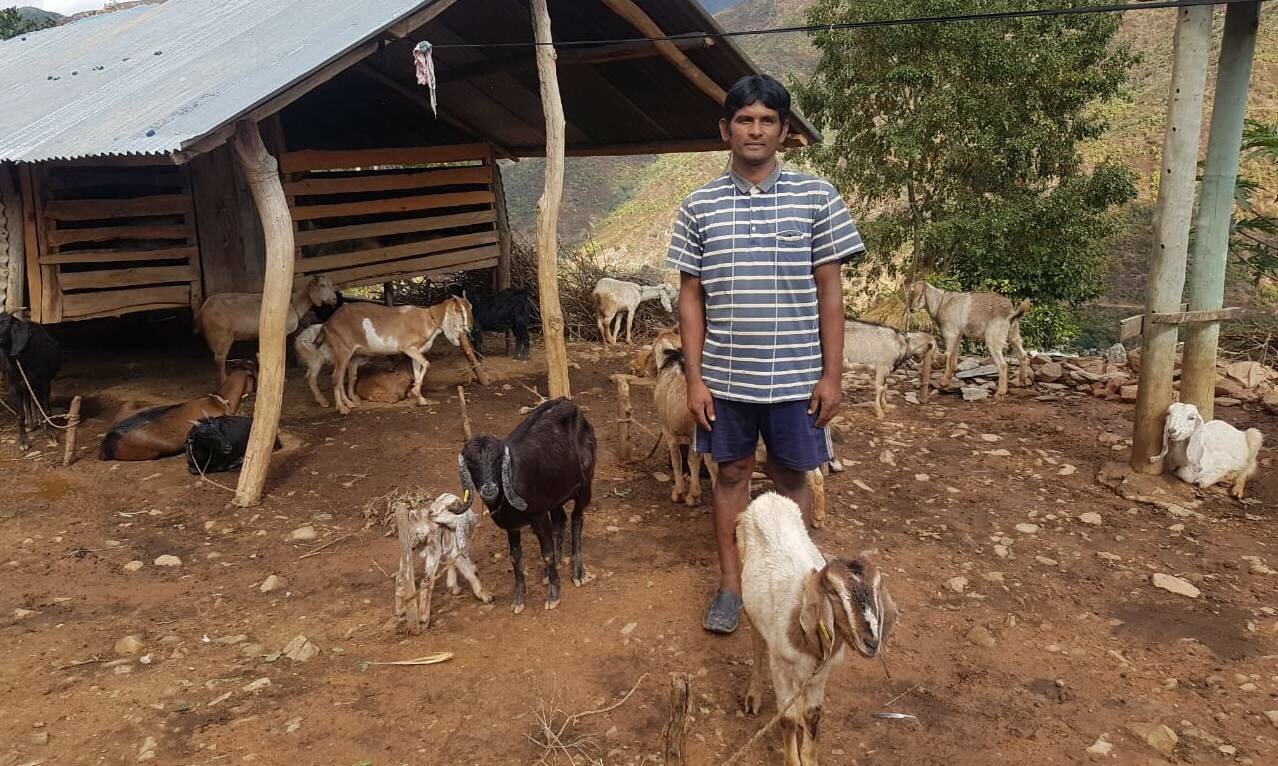In these challenging times of corona virus, it is sometimes good to read about other things. Nepal is in a state of lockdown, and many urban residents have returned to their rural roots - perhaps starting to envy those who have made a business in their village.
Following from the blog on floriculture, this blog outlines another activity that returnee migrants are adopting back in their villages: goat farming. Goats are typically raised by rural farming households as “cash for contingencies” – the sale of an animal being a source of ready money if a need arises. Goat sales are especially high just before the autumn festival of Dashain, when many families aim to slaughter a khasi (castrated male goat), the preferred meat. These days, though, the urban demand for khasi meat is an all year round one, and good profits can be made from larger scale goat rearing. This opportunity is recognized by many of the municipalities which the Nepal Agricultural Services Development Program (Prayas) is accompanying. A bilateral program of the Swiss Agency for Development and Cooperation (SDC) and the Government of Nepal, Prayas is implemented with technical support from Helvetas. It is supporting the municipalities in developing their agriculture sector in a range of ways – including facilitating the establishment of appropriate local policies, laws, and institutional mechanisms; planning in a holistic manner; delivering services effectively; and putting in place systems for financial management, reporting and monitoring.
Two municipalities, two returnee migrants
Ghanashyam Bastola and Balram Shrestha both left their villages to find work in Malaysia. Ghanashyam was successful – he worked in a bakery for five years, and was able to make some savings – but, he said, he always dreamed of returning home and raising goats. Balram Shrestha found life abroad more difficult; he was employed as a security guard at a supermarket, but the job was precarious, and he knew that if he ever fell sick for more than three days, he would be replaced. Furthermore, he had to live in cramped conditions with sixteen others, and he missed home. He returned after just nine months, in debt after all the expenditures for flights and paperwork.
Ghanashyam Bastola, Siddhicharan municipality
Ghanashyam returned home some six years ago and has had the time to build up his farm, learning in the process. He looks back at when he began and realizes that he was over-ambitious; he bought too many goats at once, and they quickly ate all the fodder that he had, requiring him to hire help to take them out to grazing land above the village. This meant, however, that he started investigating fodder options – and was identified in a municipal mapping exercise of innovative farmers, facilitated by Prayas. The project then organized a visit to the municipality of scientists of the National Agriculture Research Center (NARC), who met with these farmers and subsequently invited them to relevant (Prayas-supported) study tours. Wherever Ghanashyam went, he brought back the seed of different fodder species, and in the process has become quite a fodder expert. Different terraces of his farm are planted with different fodders, but he finds a mix of oats and vetch to be the best. As recommended by his municipality, Ghanashyam also undertook a Prayas-facilitated training as a Local Agriculture Resource Person for goats. This five-day course gave him knowledge about shed construction and management, animal health, feeding and breeding. His goats (around 40 at any one time) are now housed in a stall constructed so that their dung falls through bamboo slats to the floor below, where it is collected for compost; he is planning an improved structure which collects their urine as well.
Ghanashyam Bastola, Siddhicharan municipality
Ghanashyam is a natural and enthusiastic entrepreneur, quick to see opportunities. He has registered his goat farm as a private enterprise, which makes access to credit easier, and has taken out insurance – both practices encouraged by the municipality. Part of his business plan is also to offer training to others – these are free, although he sells fodder plants and seeds.
Balram Shrestha, Khadadevi rural municipality
Balram was unsure what to do on his return from Malaysia but was attracted to the idea of goat farming due to a grant offered by his municipality, specifically for returnee migrants. He received a grant of NRs. 70,000 (approx. USD 574) as a contribution to establishing a farm of 35 goats; in addition, vaccination of the animals was provided free of cost. After nearly three years, Balram has at least 45 goats at any one time. He reckons that returning home was the best decision that he’s made in his life.

For the municipalities, attracting returnee migrants to invest in farming makes sense as through the revenue they generate, they pay tax and employ others. According to Dr. Ramita Lama, the chief of the livestock section of Khadadevi rural municipality, “Last year we successfully retained 20 youths who returned home from abroad. They suffer many difficulties in foreign employment; as a result, they want to stay in the village and do something. Most of them ask us about business opportunities - that is when we introduce them to goat farming amongst other possibilities.”
The municipalities also recognize that market development goes hand in hand with production, and weekly markets are supported accordingly. The goats are often bought by middlemen for transportation to urban centers. For Ghanashyam and Balram, what is important is that they leave their farms as healthy animals, raised in good conditions. For a goat in Nepal, this is as much as can be expected.




